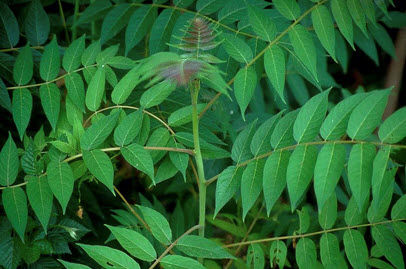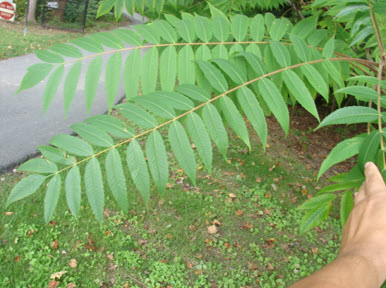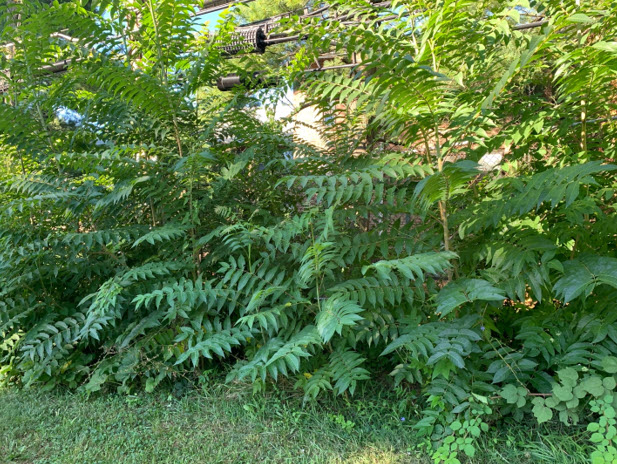An article on the invasive and destructive spotted lanternfly (actually a leafhopper) was recently posted on the Grove website. The article mentioned that tree of heaven (Ailanthus altissima) is a preferred host and should be removed from the landscape. This article describes the tree and the difficulty in its removal.
Tree of heaven is a deciduous tree with alternate compound leaves (Photo #1). Each long leaf is composed of 10 to 40 pairs of leaflets. The edges of the leaflets are smooth and without protuberances except at the base. One of its identifying features is a tiny, knobby gland at the corner of the base of the leaflet (Photo #2). Crushed leaves, especially those of the male plant, have an unpleasant odor, somewhat reminiscent of burnt peanut butter. The tree superficially resembles our native staghorn and smooth sumacs, having similar erect habit and compound leaves (Photo #3). Sumac leaflets, however, are serrated (saw-toothed) and do not have an unpleasant odor when crushed. Ailanthus has clear sap, whereas sumacs have milky, sticky sap.

Photo #1. Tree of heaven stem and leaves, which are smooth.

Photo #2. Tree of heaven leaflets and knobby gland at edges.

Photo #3. Smooth sumac leaves. Note that the edges are serrated.
In the late 18th century, tree of heaven was imported from China to the U.S. by way of France and England. Along the streets of our major cities, it was used to replace native trees which were deemed too attractive to insects. Andrew Jackson Downing (1814-1852), who was this country’s most influential plant authority prior to the Civil War, had turned against Ailanthus by the time of his death, describing the tree as a foreign invader, smelling horribly, and “suckers abominably” and “reduces to beggary all the soil of every open piece of ground.” His influence was such that nearly all the Ailanthus that had been planted just a few years before, including on the national mall, were ripped out.
Apart from the new problems caused by spotted lanternfly, tree of heaven has other undesirable characteristics, some of which were noted by Downing. It releases chemicals into the soil that inhibit growth of other plants and changes nutrient cycling and availability in invaded forests. Ailanthus grows so quickly that it reduces available light to plants growing beneath it. Female trees produce huge numbers of windborne seeds. Accordingly, it is perhaps the most aggressive, non-native invasive tree in much of the U.S. Ailanthus made for a good metaphor in “A Tree Grows in Brooklyn”, as it is known to grow and thrive in the most inhospitable, urban locations. Chances are good that a small tree growing out of a cracked sidewalk is likely to be a tree of heaven.
Tree of heaven grows and spreads rapidly in disturbed soil in full sun (Photo #4). Due to its extensive root system and resprouting ability, simply cutting it down will not get rid of it. Dozens of stump and root sprouts will soon pop up and must be treated quickly because sprouts as young as two years can produce seeds. Because of its resprouting ability, most authorities recommend applying an herbicide to the tree between mid-July and October, followed by removal of the tree between November and April.

Photo 4. Thicket of tree of heaven off Washington Grove Lane.
If unsure of identifying tree of heaven, you are welcome to contact Jay Everhart ([email protected]) for assistance.
